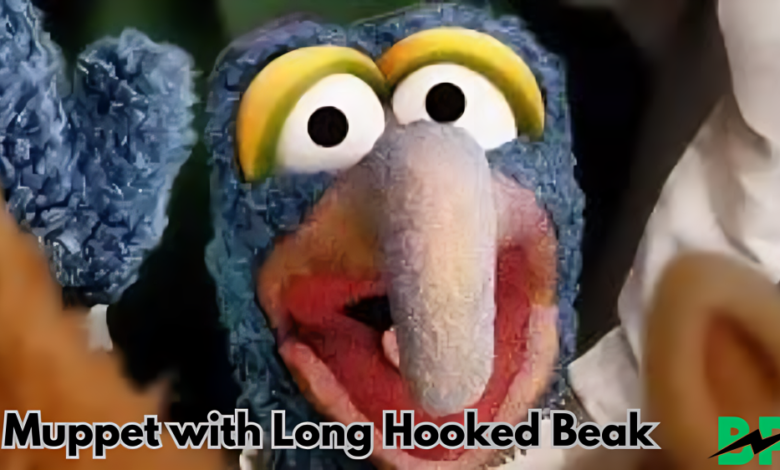Muppet with Long Hooked Beak A Unique Character in Puppetry

Puppetry has long fascinated audiences across the globe, blending the world of fantasy with intricate designs. One particularly interesting character that has piqued curiosity is the Muppet With Long Hooked beak. This unique design stands out due to its distinctive features and provides both entertainment and an avenue for storytelling. In this article, we delve into the world of muppets, focusing on this character’s anatomy, significance in the puppetry world, and why it captures the attention of so many.
Anatomy of the Muppet with a Long Hooked Beak
When we think of muppets, various characters come to mind. However, the muppet with a long hooked beak holds a special place due to its unconventional and artistic design. The hooked beak is not just a random feature; it serves a functional and aesthetic purpose.
Beak Structure and Functionality
The long hooked beak is often seen in characters resembling birds or mystical creatures. Its curvature gives the character an eccentric yet charismatic appearance. These beaks are typically constructed with lightweight materials to ensure ease of movement during performances. Despite their length and distinct structure, puppeteers ensure that the beak’s weight does not interfere with the character’s agility.
Artistic Symbolism
From an artistic standpoint, the hooked beak often symbolizes traits like cunning, wisdom, or mystery. Its exaggerated shape allows the muppet to stand out on stage or screen, making it an iconic figure in the realm of puppetry. Such features are designed to create memorable interactions with the audience, keeping them engaged with both the visual and narrative aspects of the character.
Historical Context of the Muppet with a Long Hooked Beak
Puppetry has ancient roots, tracing back to various cultures across continents. The use of animal-like features, such as the long hooked beak, often draws inspiration from traditional stories and legends. The design of the muppet with a long hooked beak might be influenced by mythological creatures or exotic birds that symbolize certain traits in folklore.
Cultural Inspirations
In several cultures, birds with hooked beaks are seen as powerful or mystical creatures. For instance, the owl, known for its wisdom, and the falcon, renowned for its sharpness and predatory instincts, often inspire muppet characters. By incorporating a long hooked beak, puppeteers add a layer of cultural depth to their creations, making these characters more than just entertainment they become symbols of deeper meaning and storytelling.
Evolution of Design in Modern Puppetry
The evolution of muppet design, particularly those featuring long hooked beaks, has seen significant development. Initially, such designs were limited by the technology of the time. Today, with advancements in materials and animation, the muppet with a long hooked beak can move fluidly, allowing for more expressive performances. Modern puppeteers integrate technology with tradition, maintaining the character’s iconic features while enhancing its functionality.
Significance of the Muppet with a Long Hooked Beak in Popular Media
The muppet with a long hooked beak is not merely a design choice; it plays a crucial role in the storytelling process. Characters with distinct features such as these often have specific personality traits that resonate with audiences. Whether portraying a wise sage, a trickster, or a misunderstood creature, the long hooked beak becomes a focal point in defining the character’s role.
Memorable Characters with Hooked Beaks
Over the years, numerous muppets and puppet characters with long hooked beaks have graced television and stage productions. These characters tend to have exaggerated personalities, often playing the role of comic relief, wise mentors, or even villains. The hooked beak, much like other distinctive features, serves as a visual cue for the audience, indicating the character’s role or personality without the need for verbal explanation.
Impact on Audience Perception
The exaggerated design of the muppet with a long hooked beak often elicits an immediate reaction from viewers. Whether it’s laughter, curiosity, or intrigue, this distinctive feature draws attention. Puppeteers and creators use this design as a tool to create a lasting impression, ensuring the character remains memorable long after the show ends.
Crafting a Muppet with a Long Hooked Beak: Behind the Scenes
Creating a muppet with a long hooked beak is no small feat. It requires a blend of creativity, craftsmanship, and technical skill to bring this character to life. The process involves several stages, from conceptualization to execution, each contributing to the final design that audiences see on stage or screen.
Design and Material Selection
The first step in crafting a long hooked beak involves choosing the right materials. Lightweight yet durable materials are preferred to ensure the beak is functional and easy to manipulate. Foam, felt, and wire are commonly used to create the base structure, while details such as feathers, paint, or fabric may be added for aesthetic purposes.
Puppeteering Techniques
Master puppeteers must learn specific techniques to manipulate the long hooked beak during performances. The beak’s movement needs to be synchronized with the character’s dialogue and actions, adding realism to the performance. Through practice and precision, the muppet with a long hooked beak becomes an extension of the puppeteer, captivating audiences with its lifelike qualities.
FAQs
Q: What materials are used to create the muppet with a long hooked beak?
A: The long hooked beak is typically made from lightweight materials such as foam, felt, and wire. These materials provide the flexibility and durability needed for movement during performances.
Q: What is the significance of the long hooked beak in muppet design?
A: The long hooked beak often symbolises traits such as wisdom, mystery, or cunning. Its exaggerated shape helps the character stand out and adds depth to its role in storytelling.
Q: Why are characters with long hooked beaks popular in puppetry?
A: Characters with long hooked beaks are popular because their distinctive features make them visually engaging. Additionally, these characters often play important roles in stories, making them memorable to audiences.
Q: How do puppeteers control the movement of a muppet with a long hooked beak?
A: Puppeteers use specialised techniques to manipulate the long hooked beak during performances. This requires practice and precision to ensure the beak’s movement is fluid and synchronised with the character’s actions.
Conclusion
The Muppet With Long Hooked Beak is an iconic figure in the world of puppetry, blending artistry, symbolism, and craftsmanship into a single character. Its distinctive design not only captures the audience’s attention but also serves as a critical tool in storytelling. Whether it’s a symbol of wisdom, mystery, or cunning, this character’s unique features make it a memorable addition to any performance. From its carefully crafted anatomy to its cultural significance, the muppet with a long hooked beak remains an enduring and beloved part of puppet history, continuing to entertain and inspire audiences of all ages.




